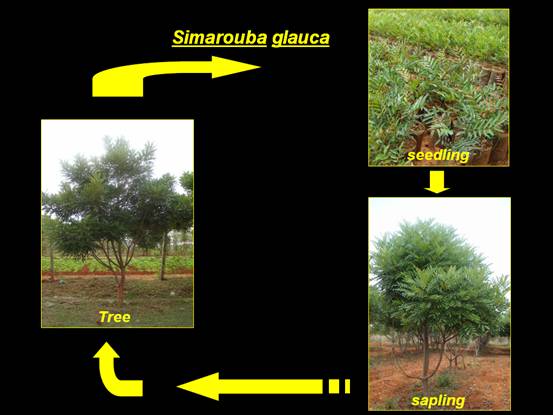
|
||
| Home | About Forestry | Eco-Tourism | Forestry Addresses | FAQs | Contact Us | Disclaimer | |
||
| Industrial Forestry | ||
BIOFUEL SPECIES
Origin: New Introduction from El Salvador, (Brazil).The tree is commonly found in Brazil at elevations ranging from sea level to 3000 feet, but the more heavily populated natural stands are encountered at medium elevation of 1,500 to 2,500 ft. prefers sub humid climates with annual precipitations of between 800 and 2000 millimetres and temperature from 20 to 26°C. Rotation age (felling age): 60-80 years Spacing: 4 m x 4m, 6 m x 8 m. Preparatory cultivation: The preparation of the site is completed by May-June, and ploughing with disc is initially suggested. Nursery: Simaruba seedlings are raised during April-June in poly bags filled with nursery mixture. Seedlings older than 2 months can be transplanted. The grafts of elite lines or the apomietic seedlings with known sex should preferred for planting to get higher and earlier returns. Planting: In rain fed marginal lands / Wastelands transplanting is done in the beginning of monsoon so that the plants can establish well by the end of raining season. Pit size: 45 x 45 x 45 cm size pits are filled with top soil and 3-5 kg compost. The plants grow well with a protective watering of 2-5 l/week during the first summer. After care: Regular weeding in the first two years of growth is recommended. Special feature: For effective pollination and good bearing planting of male and female plants in a 1:20 ratio in the right geometry is advocated (or) some selected female plants may be grafted with a few branches, of high yielding male plant grafts. Plant protection: No major pest and diseases; only some mites and bark feeders are reported. Yield: Simaruba seeds contain 60-65 percent oil; each well grown tree yields up to 10 kg of seeds (i.e. 5-6 kg of oil and 4-5 kg of oil cake) and a well established plantation gives an oil yield of 600- 800 kg/ha/ year after 10 years of planting. Uses: Edible oil, soap making, medicinal value, remedy for diarrhoea, lubricants, varnishes, light furniture, match sticks. |
||
| Home | About Forestry | Eco-Tourism | Forestry Addresses | FAQs | Contact Us | Disclaimer |
© All Rights Reserved. TNAU-2016 |
||
